CWS Offices on Balloon
Street and Garden Street



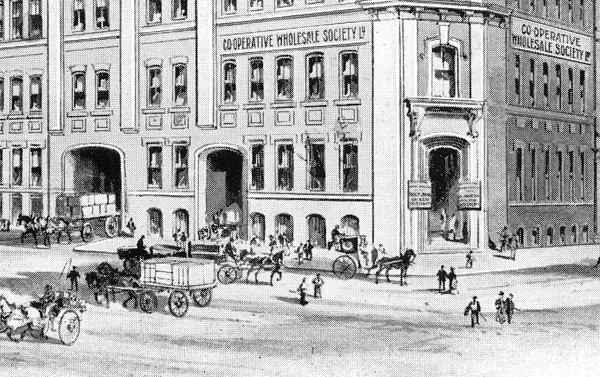
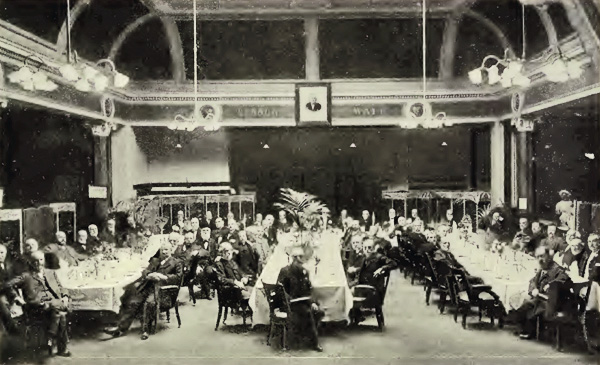
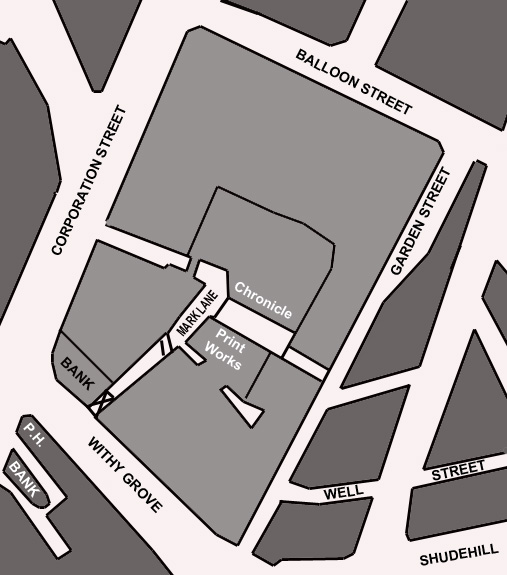
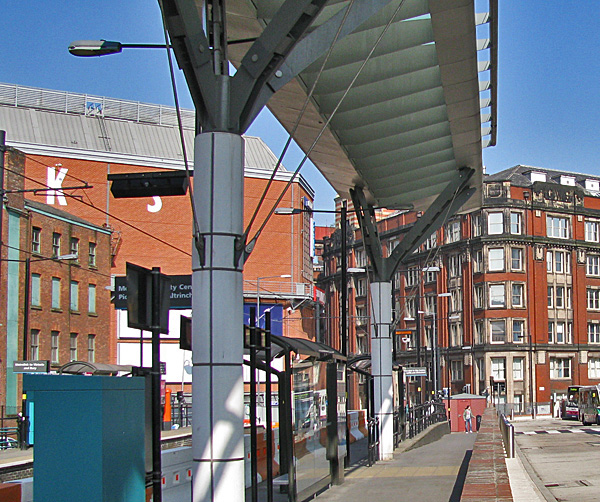

The Co-operative Wholesale
Society still owns a number of large
office/warehouse buildings in the area between
Dantzig Street and Corporation Street.
Most of them are still occupied by the company
in 2012, although the new headquarters building
reaching completion nearby will mean that the
employees will soon be moving out. This
building appears to be the first of a series of
buildings to be built by the Society in this
vicinity. Ironically it is the one that
didn't survive to the present day.
The CWS published an account of the Society's history in a book entitled "THE STORY OF THE C.W.S.
THE JUBILEE HISTORY OF THE CO-OPERATIVE WHOLESALE SOCIETY LIMITED. 1863-1913. BY PERCY REDFERN." That document contains an account of the origins of this building.
The CWS published an account of the Society's history in a book entitled "THE STORY OF THE C.W.S.
THE JUBILEE HISTORY OF THE CO-OPERATIVE WHOLESALE SOCIETY LIMITED. 1863-1913. BY PERCY REDFERN." That document contains an account of the origins of this building.
"This year, 1866,
appears to have marked a turning point,
beyond which the federation was no more to
be dependent almost for its existence upon
timely and substantial loans from the more
prosperous and friendly retail societies.
Shares were accumulating out of retained
dividends, so that in 1867 certain
additional offers of money could be declined
" on account of having too much in the
bank." New developments quickly resulted
from this condition, and still more
warehouse room became urgently needed. Land
was purchased, therefore, in the adjacent
byways, Balloon Street and Garden Street,
and in the next year powers were obtained to
spend up to 10,000 upon building a warehouse
of the Society's own.
It is notable that at this meeting, also, the Directors got into trouble for buying the Balloon Street land, presumably without the previous sanction of the delegates. While they were " exonerated from blame " (the ground has since increased hugely in market value)" the meeting objected to it being regarded as a precedent."
... the main business of the year 1868 was the erection, at a contracted cost of 4,040, of the six-storey building that still occupies the corner of Balloon Street and Garden Street. A special building committee was formed and the work pushed forward. Difficulties with an owner of neighbouring property led to legal action on the part of the latter. Their light and air " were being encroached upon by the vastness of the new building." But, rather than waste time and money upon going into court, the Committee offered "reparation," which was accepted. Without further delay the work proceeded, and, early in 1869, the six-storey, sky-scraping new warehouse, perilously huge and ambitious as it seemed, was ready for business.
Balloon Street since then has become entirely a possession of the "Wholesale;" and, as the formal address of the Society's headquarters, the street is now known far and wide. It is worth remembering, therefore, that the name is not meaningless, nor does it preserve incongruously the memory of some private speculator. History is in it, even though of a mild character. Hereabouts, on May 12th, 1785, a certain James Sadler made one of the first balloon ascents witnessed in England. At that date obviously the area formed an open field. Very shortly afterwards the ground was covered with small houses ; but the feat that astonished Manchester was properly commemorated in the name since associated with the rise of the C.W.S. When the federation came to make its home in the street, all the vicinity had become, or was rapidly becoming, a slum. Garden Street, now chiefly a siding for co-operative wagons, retained nothing pleasant but its name, and a fading memory of the Royal Infirmary of Manchester originally having been housed in it. Clock Alley existed, since obliterated by the C.W.S. ; while Corporation Street only recently had been driven from Withy Grove through a maze of byways. The way to a small and congested Victoria Station went down and up the banks of the Irk, the stream (which now needs searching for) being crossed by a wooden footbridge. The Committee contemplated a ceremonial opening of the Society's first property, in the presence of a galaxy of statesmen, peers, professors, and philanthropists; but of the great men invited only such tried friends as J. M. Ludlow, Hugh Birley, M.P., the Rev. W. N. Molesworth (Vicar of Rochdale), G. J. Holyoake, Lloyd Jones, and others were present."
It is notable that at this meeting, also, the Directors got into trouble for buying the Balloon Street land, presumably without the previous sanction of the delegates. While they were " exonerated from blame " (the ground has since increased hugely in market value)" the meeting objected to it being regarded as a precedent."
... the main business of the year 1868 was the erection, at a contracted cost of 4,040, of the six-storey building that still occupies the corner of Balloon Street and Garden Street. A special building committee was formed and the work pushed forward. Difficulties with an owner of neighbouring property led to legal action on the part of the latter. Their light and air " were being encroached upon by the vastness of the new building." But, rather than waste time and money upon going into court, the Committee offered "reparation," which was accepted. Without further delay the work proceeded, and, early in 1869, the six-storey, sky-scraping new warehouse, perilously huge and ambitious as it seemed, was ready for business.
Balloon Street since then has become entirely a possession of the "Wholesale;" and, as the formal address of the Society's headquarters, the street is now known far and wide. It is worth remembering, therefore, that the name is not meaningless, nor does it preserve incongruously the memory of some private speculator. History is in it, even though of a mild character. Hereabouts, on May 12th, 1785, a certain James Sadler made one of the first balloon ascents witnessed in England. At that date obviously the area formed an open field. Very shortly afterwards the ground was covered with small houses ; but the feat that astonished Manchester was properly commemorated in the name since associated with the rise of the C.W.S. When the federation came to make its home in the street, all the vicinity had become, or was rapidly becoming, a slum. Garden Street, now chiefly a siding for co-operative wagons, retained nothing pleasant but its name, and a fading memory of the Royal Infirmary of Manchester originally having been housed in it. Clock Alley existed, since obliterated by the C.W.S. ; while Corporation Street only recently had been driven from Withy Grove through a maze of byways. The way to a small and congested Victoria Station went down and up the banks of the Irk, the stream (which now needs searching for) being crossed by a wooden footbridge. The Committee contemplated a ceremonial opening of the Society's first property, in the presence of a galaxy of statesmen, peers, professors, and philanthropists; but of the great men invited only such tried friends as J. M. Ludlow, Hugh Birley, M.P., the Rev. W. N. Molesworth (Vicar of Rochdale), G. J. Holyoake, Lloyd Jones, and others were present."
*********************
This account accompanied the drawing at the top of the page.

This account accompanied the drawing at the top of the page.

The 1840 map of the area,
shown below, obviously pre-dates the CWS
building but it does show the infamous Clock
Alley mentioned above and the numerous dwellings
in the vicinity.

By the time the Goad Map of
the area was drawn, circa 1880, the building can
be seen occupying a large portion of the block
as well as another building across Garden
Street.

As you can see in the map
above, the CWS shared the block with The Old
Boar's Head Hotel, The Crosby Hotel, Kilvert
& Sons Lard Refining Works and the Evening
Chronicle.

Below is an image taken at a
reunion of the Past and Present Directors,
Auditors and Scrutineers in the Balloon Street
Old Dining Room, August 23rd, 1905

By the time the 1933 map of
the area was published, the block seems to have
become simplified with the Chronicle having
become a much larger occupant and the Old Boar's
Head being replaced by a bank.

If the World War II bomb
damage maps in the Manchester Local History
Archive are accurate, it appears that this
building survived the carnage that occurred
around it during the Christmas Blitz. I
don't know when the building disappeared from
the corner of Balloon Street and Garden Street
but I have seen a photograph in the Manchester
Image Archive that shows it in 1964.
However, at some point between then and the end
of the 1990s the former newspaper offices on
Withy Grove and the CWS building site were
incorporated into a modern entertainment centre
called The Printworks.
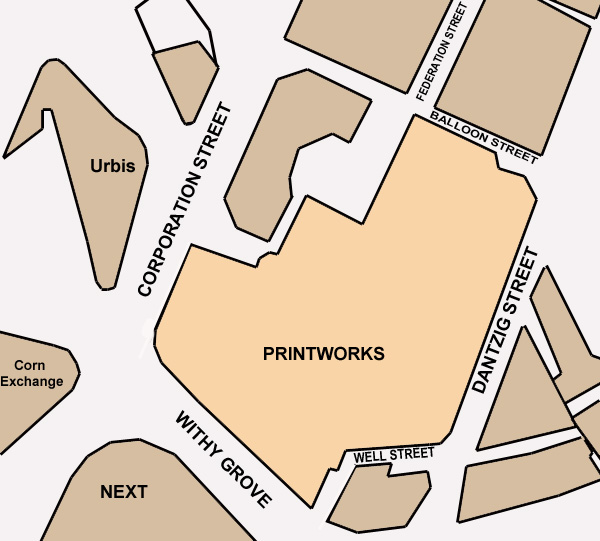
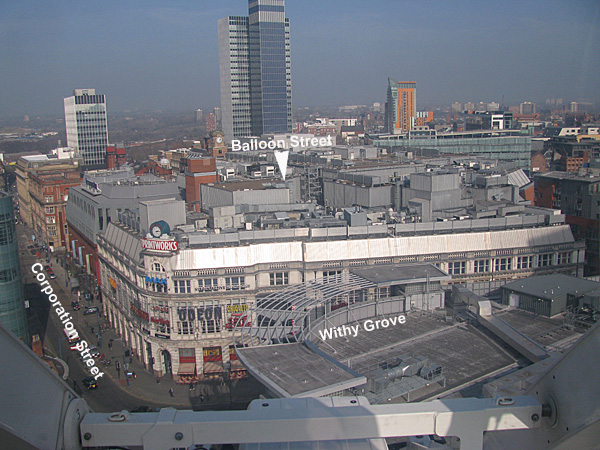
Below is an image taken from the Shudehill Interchange looking towards Balloon Street. The back of the Printworks can be seen on the left. This would be the same corner shown in the drawing at the top of this page.

You can see the block today
in the image below. You are looking at
it from the Withy Grove end.

Below is an image taken from the Shudehill Interchange looking towards Balloon Street. The back of the Printworks can be seen on the left. This would be the same corner shown in the drawing at the top of this page.
